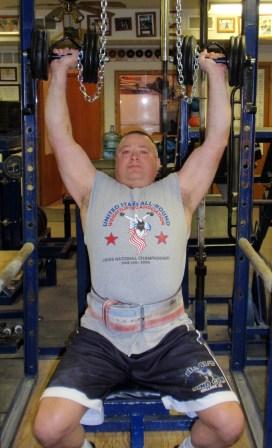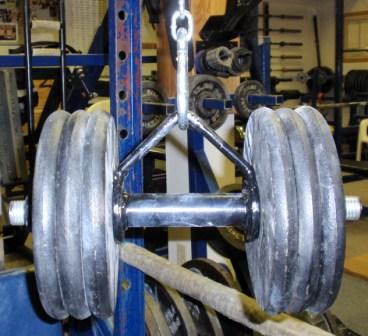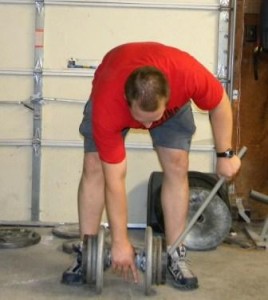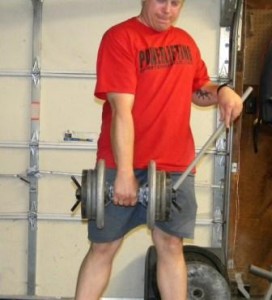Hanging Dumbbell Presses
by Al Myers

Al Myers demonstrating a Hanging Dumbbell Press, using a special made dumbbell handle that attaches to a chain that suspends the dumbbells at shoulder height.
A few months ago I started a training program utilizing seated dumbbell presses with the hope that they would be less stressful on my shoulder joints than straight bar shoulder presses. Years ago I did LOTS of dumbbell presses and really liked them. The natural rotation of pressing dumbbells feels better on your shoulders than a straight bar. Pressing dumbbells also makes you very aware of shoulder strength imbalances. With a bar, some of these “imbalances” can be compensated for with the stronger shoulder – but with a dumbbell that weakness is EXPOSED very quickly! I started this dumbbell training program after Worlds in which I was VERY disappointed with my dumbbell press at that meet. I have been able to “hide” my weak left arm pressing strength for quite a while by just using my right in competitions that require a lift to be done one handed. But at Worlds the Scots pulled a mean trick on me – and put in place a “meet rule” that required both one arm lifts to be performed with alternate arms. I really wanted to snatch with my right, so the dumbbell press was “left” to my “left”. Needless to say, I did less for a max standing than what I USED to do for 5 reps seated.
I started the program out easy with light dumbbells and progressed a little every week. My shoulders felt great. No front delt shoulder pain. However, soon I reached a point when the dumbbell poundages got heavy enough that I remembered another problem that dumbbell pressing causes. My elbows started hurting!!! My elbow tendinitis flared back to full force like the days when I was bench pressing heavy. Back then, it was a standard practice of mine to ice my elbows for an hour after every bench training session. I don’t really want to go back to doing that now – just for dumbbell pressing! The act of hammer curling or cleaning the dumbbells to my shoulders was the culprit here. I was about ready to give up on dumbbell pressing because of this – but then I came up with a BETTER WAY!
I decided to make a “special” dumbbell handle that could be hung suspended overhead from my rack at the seated shoulder height. This way I could hang the dumbbell using both hands – thus taking out the part of the lift that was causing me the elbow pain that seemed unnecessary. Now with the dumbbells already hanging, I just “take my seat” and start pressing! I also feel a lot safer because if for any reason I would lose control of the dumbbells they would be “caught” by the chain and not do any damage to the floor or myself! I have never heard of read of anyone else making a dumbbell handle like this so I want to share this idea. Someone else may already have done this, so I’m not going to make any claim to this idea. That’s not my point. If it would help someone else experiencing this same problem as myself and this idea would help them – that is enough for me. The handle was very easy to make, and hopefully, will help build up my dumbbell press once again.


